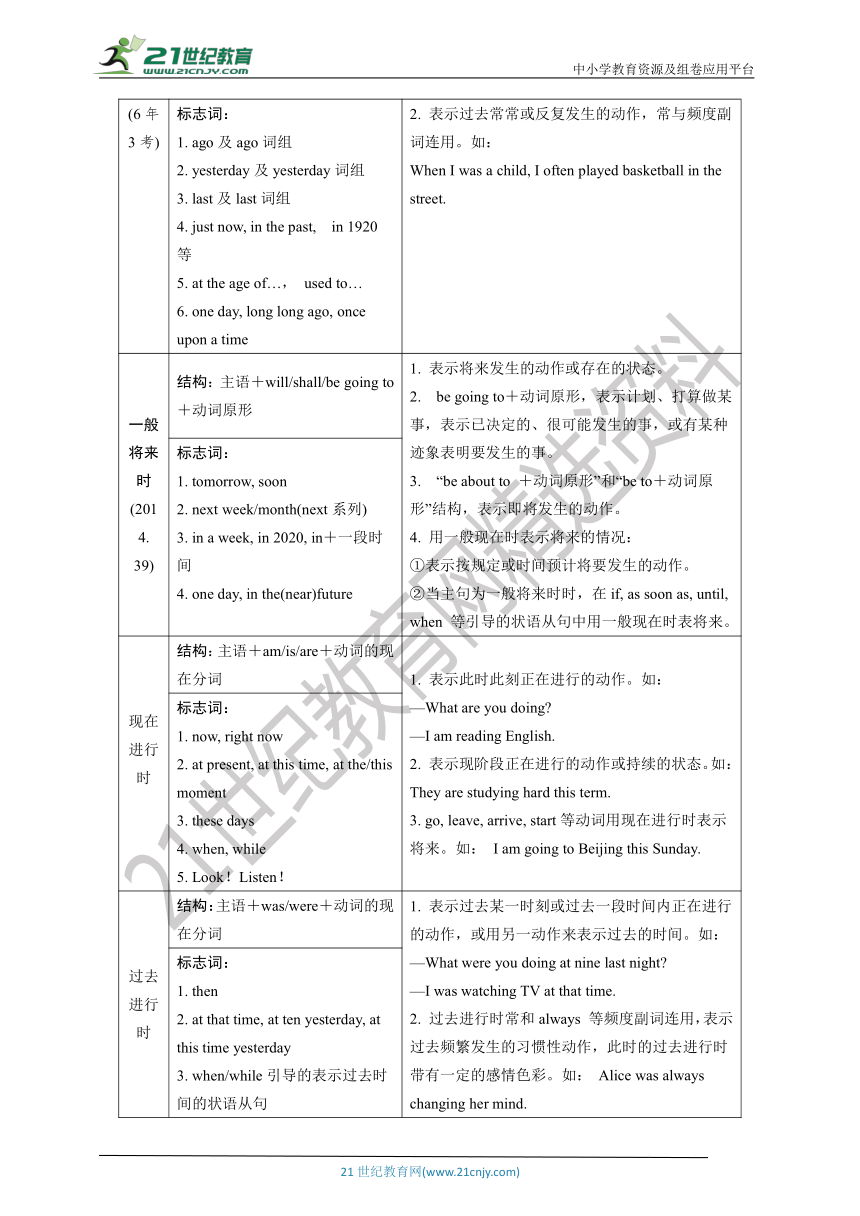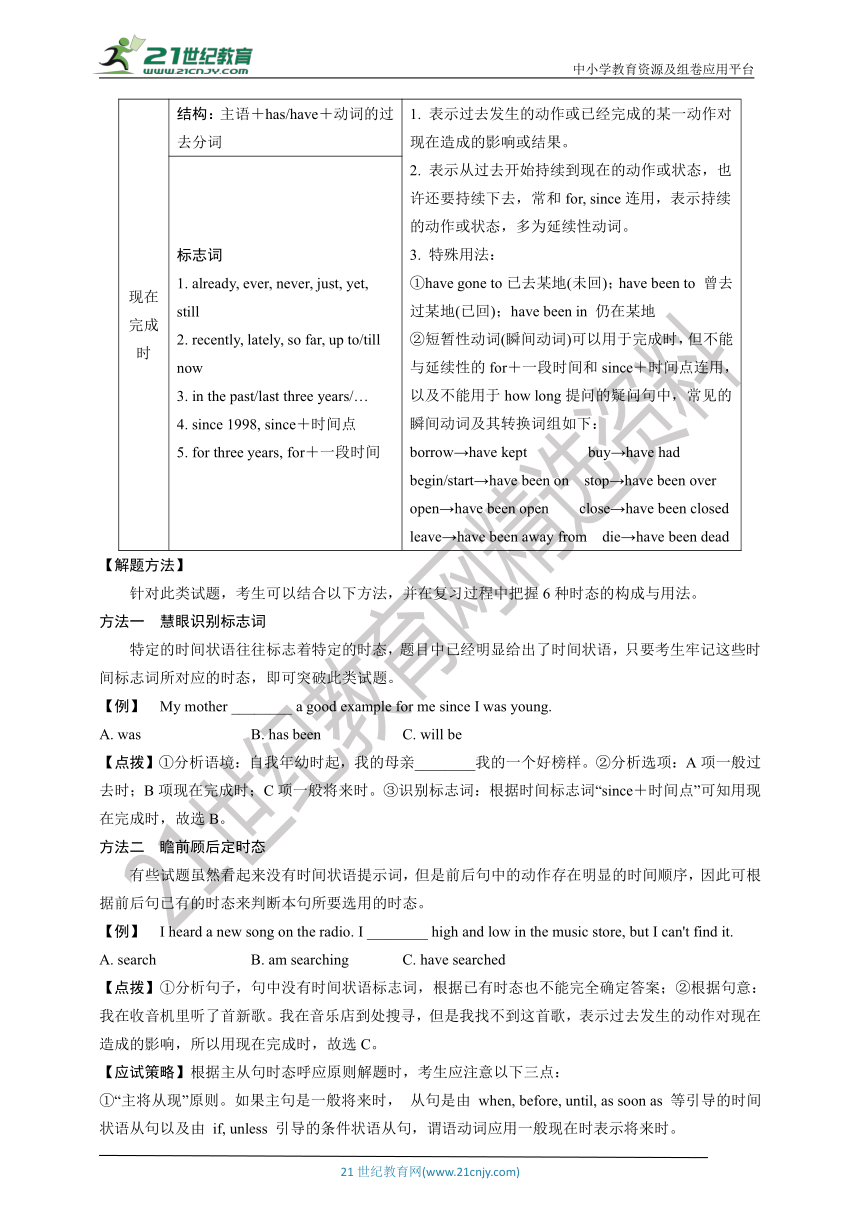2020年广西中考英语备考语法专题系列导学案:动词的时态(含答案)
文档属性
| 名称 | 2020年广西中考英语备考语法专题系列导学案:动词的时态(含答案) |  | |
| 格式 | zip | ||
| 文件大小 | 1.1MB | ||
| 资源类型 | 试卷 | ||
| 版本资源 | 通用版 | ||
| 科目 | 英语 | ||
| 更新时间 | 2020-02-25 21:43:31 | ||
图片预览



文档简介
第一部分 语法专题突破
专题十
(必考:每年1-2道)
知识导图
考 点 精 讲
分析近6年柳州真题可知,动词的时态均在单项选择中考查,选项设置上多为不同的时态。其中,一般现在时(均含有提示词:every day, every morning, often)和一般过去时(均由语境推断时态)各考查3次;一般将来时考查1次,含有时间提示词tomorrow。
英语中各种时态的使用频率不同,下面是初中阶段常考的六种时态。
常考6种时态的构成与用法
时态
基本结构及时间标志词
常见用法及例句
一般
现在时
(6年
3考)
结构:主语+am/is/are
主语+动词原形/动词单三形式
1. 表示现阶段经常性、习惯性的动作,常与频度副词连用。
2. 表示客观真理、客观存在或自然现象。
(注意:此用法如果出现在宾语从句中,即使主句是过去时,从句谓语也要用一般现在时。)
3. 用在以if, unless, as soon as, when, once等引导的时间和条件状语从句中,用一般现在时表示将来时。
4. 表示按计划或安排将要发生的动作,用一般现在时表将来,但仅限于start, begin, leave, go, come, arrive等动词。
标志词:
1. 频度副词:always, usually, often, sometimes, seldom, hardly, never
2. 频率词组:once a year, twice a month, three times a day等
3. 其他词组:in the morning, on Sundays, at weekends, every day/year…(every系列)
一般
过去时
(6年
3考)
结构:主语+was/were主语+动词过去式
1. 表示过去某个时间所发生的动作或存在的状态。如:
We went to the City Library last week.
2. 表示过去常常或反复发生的动作,常与频度副词连用。如:
When I was a child, I often played basketball in the street.
标志词:
1. ago及ago词组
2. yesterday及yesterday词组
3. last及last词组
4. just now, in the past, in 1920等
5. at the age of…, used to…
6. one day, long long ago, once upon a time
一般
将来时
(2014.
39)
结构:主语+will/shall/be going to+动词原形
1. 表示将来发生的动作或存在的状态。
2. be going to+动词原形,表示计划、打算做某事,表示已决定的、很可能发生的事,或有某种迹象表明要发生的事。
3. “be about to +动词原形”和“be to+动词原形”结构,表示即将发生的动作。
4. 用一般现在时表示将来的情况:
①表示按规定或时间预计将要发生的动作。
②当主句为一般将来时时,在if, as soon as, until, when 等引导的状语从句中用一般现在时表将来。
标志词:
1. tomorrow, soon
2. next week/month(next系列)
3. in a week, in 2020, in+一段时间
4. one day, in the(near)future
现在
进行时
结构:主语+am/is/are+动词的现在分词
1. 表示此时此刻正在进行的动作。如:
—What are you doing?
—I am reading English.
2. 表示现阶段正在进行的动作或持续的状态。如:
They are studying hard this term.
3. go, leave, arrive, start等动词用现在进行时表示将来。如: I am going to Beijing this Sunday.
标志词:
1. now, right now
2. at present, at this time, at the/this moment
3. these days
4. when, while
5. Look!Listen!
过去
进行时
结构:主语+was/were+动词的现在分词
1. 表示过去某一时刻或过去一段时间内正在进行的动作,或用另一动作来表示过去的时间。如:
—What were you doing at nine last night?
—I was watching TV at that time.
2. 过去进行时常和always 等频度副词连用,表示过去频繁发生的习惯性动作,此时的过去进行时带有一定的感彩。如: Alice was always changing her mind.
标志词:
1. then
2. at that time, at ten yesterday, at this time yesterday
3. when/while引导的表示过去时间的状语从句
现在
完成时
结构:主语+has/have+动词的过去分词
1. 表示过去发生的动作或已经完成的某一动作对现在造成的影响或结果。
2. 表示从过去开始持续到现在的动作或状态,也许还要持续下去,常和for, since连用,表示持续的动作或状态,多为延续性动词。
3. 特殊用法:
①have gone to已去某地(未回);have been to 曾去过某地(已回);have been in 仍在某地
②短暂性动词(瞬间动词)可以用于完成时,但不能与延续性的for+一段时间和since+时间点连用,以及不能用于how long提问的疑问句中,常见的瞬间动词及其转换词组如下:
borrow→have kept buy→have had
begin/start→have been on stop→have been over
open→have been open close→have been closed
leave→have been away from die→have been dead
标志词
1. already, ever, never, just, yet, still
2. recently, lately, so far, up to/till now
3. in the past/last three years/…
4. since 1998, since+时间点
5. for three years, for+一段时间
【解题方法】
针对此类试题,考生可以结合以下方法,并在复习过程中把握6种时态的构成与用法。
方法一 慧眼识别标志词
特定的时间状语往往标志着特定的时态,题目中已经明显给出了时间状语,只要考生牢记这些时间标志词所对应的时态,即可突破此类试题。
【例】 My mother ________ a good example for me since I was young.
A. was B. has been C. will be
【点拨】①分析语境:自我年幼时起,我的母亲________我的一个好榜样。②分析选项:A项一般过去时;B项现在完成时;C项一般将来时。③识别标志词:根据时间标志词“since+时间点”可知用现在完成时,故选B。
方法二 瞻前顾后定时态
有些试题虽然看起来没有时间状语提示词,但是前后句中的动作存在明显的时间顺序,因此可根据前后句已有的时态来判断本句所要选用的时态。
【例】 I heard a new song on the radio. I ________ high and low in the music store, but I can't find it.
A. search B. am searching C. have searched
【点拨】①分析句子,句中没有时间状语标志词,根据已有时态也不能完全确定答案;②根据句意:我在收音机里听了首新歌。我在音乐店到处搜寻,但是我找不到这首歌,表示过去发生的动作对现在造成的影响,所以用现在完成时,故选C。
【应试策略】根据主从句时态呼应原则解题时,考生应注意以下三点:
①“主将从现”原则。如果主句是一般将来时, 从句是由 when, before, until, as soon as 等引导的时间状语从句以及由 if, unless 引导的条件状语从句,谓语动词应用一般现在时表示将来时。
②“时态一致”原则。在含有宾语从句的主从复合句中,当主句的谓语动词为过去时态时,从句的谓语动词也需用过去的某种时态。
③在主从复合句中,如果主句和从句的谓语动词表示的两个动作都发生在过去,而且有明显的先后顺序,那么,延续性动词用过去进行时,短暂性动词用一般过去时。通常在when和while引导的时间状语从句中出现。
方法三 细心体会辨语境
在绝大多数情况下,动词的时态是由上下文的语境来决定的,这就要求考生一方面要熟记各种时态的适用范围,另一方面要注意上下文想表达什么样的语意。因此。如果一个英语句子中没有出现时间状语,则应该分析上下文已有的时态信息,然后再确定空格处的时态。
【例】 When I was in primary school, the books ________ me to a wonderful world.
A. brought B. are bringing C. have brought
【点拨】①分析语境:当我在读小学时,那些书________ 我一个美妙的世界,②分析选项:A项一般过去时;B项现在进行时;C项现在完成时;③根据语境判断具体时态。句首“When I was in primary school...”暗示主体时态为一般过去时,所以此处应用一般过去时,故选A。
综 合 提 升
柳州6年真题(2014~2019)
1. (2019柳州31题)I ________ to school on foot every day.
A. go B. went C. has gone
2. (2018柳州32题)I ________ up at 6:30 every morning.
A. get B. got C. will get
3. (2016柳州39题)I often ________ books in the evening.
A. reads B. read C. reading
4. (2014柳州39题)—What are you going to do tomorrow?
—I________ visit my aunt.
A. went to B. go to C. am going to
5. (2018柳州24题)It has started to rain. It's wise that we ________ to the park.
A. didn't go B. aren't going C. don't go
6. (2017柳州40题)—Mr Smith isn't coming tonight.
—But he________.
A. promised B. promises C. will promise
7. (2015柳州42题)—I ________ know you can play the piano so well.
—Thank you.
didn't B. don't C. can't
6年真题精选
8. (2019梧州30题)My uncle________ in England since ten years ago.
A. lives B. lived C. will live D. has lived
9. (2019桂林35题)He hasn't communicated much with his parents since he ________ a mobile phone last year.
A. got B. get C. gets
10. (2018桂林34题)Look! They ________ basketball on the playground.
A. play B. plays C. are playing
11. (2017桂林40题)Our science teacher said that light ________ much faster than sound.
A. traveled B. travels C. travel
增补训练
12. Listen! Mr.Black ________ a talk on robots in the hall.
A. gives B. is giving C. will gave
13. Michael________ at a school in Yunnan Province from February to June next year.
A. teach B. taught C. will teach
14. They ________ about a show this time yesterday.
A. were talking B. are talking C. have talked
15. Her grandpa________ for many years. Now he is in good health.
A. exercises B. has exercised C. exercised
16. —The bread is really delicious.
—Thank you. I ________ it myself just now.
A. make B. am making C. made
17. Gary is the best singer in my class. No one else ________ so well.
A. sings B. sang C. is singing
18. We hope to manage our own life because we ________ up.
A. grew B. grow C. have grown
19. I think if Julia helps with my English, I ________ my English a lot.
A. will improve B. improve C. have improved
专题十
(必考:每年1-2道)
知识导图
考 点 精 讲
分析近6年柳州真题可知,动词的时态均在单项选择中考查,选项设置上多为不同的时态。其中,一般现在时(均含有提示词:every day, every morning, often)和一般过去时(均由语境推断时态)各考查3次;一般将来时考查1次,含有时间提示词tomorrow。
英语中各种时态的使用频率不同,下面是初中阶段常考的六种时态。
常考6种时态的构成与用法
时态
基本结构及时间标志词
常见用法及例句
一般
现在时
(6年
3考)
结构:主语+am/is/are
主语+动词原形/动词单三形式
1. 表示现阶段经常性、习惯性的动作,常与频度副词连用。
2. 表示客观真理、客观存在或自然现象。
(注意:此用法如果出现在宾语从句中,即使主句是过去时,从句谓语也要用一般现在时。)
3. 用在以if, unless, as soon as, when, once等引导的时间和条件状语从句中,用一般现在时表示将来时。
4. 表示按计划或安排将要发生的动作,用一般现在时表将来,但仅限于start, begin, leave, go, come, arrive等动词。
标志词:
1. 频度副词:always, usually, often, sometimes, seldom, hardly, never
2. 频率词组:once a year, twice a month, three times a day等
3. 其他词组:in the morning, on Sundays, at weekends, every day/year…(every系列)
一般
过去时
(6年
3考)
结构:主语+was/were主语+动词过去式
1. 表示过去某个时间所发生的动作或存在的状态。如:
We went to the City Library last week.
2. 表示过去常常或反复发生的动作,常与频度副词连用。如:
When I was a child, I often played basketball in the street.
标志词:
1. ago及ago词组
2. yesterday及yesterday词组
3. last及last词组
4. just now, in the past, in 1920等
5. at the age of…, used to…
6. one day, long long ago, once upon a time
一般
将来时
(2014.
39)
结构:主语+will/shall/be going to+动词原形
1. 表示将来发生的动作或存在的状态。
2. be going to+动词原形,表示计划、打算做某事,表示已决定的、很可能发生的事,或有某种迹象表明要发生的事。
3. “be about to +动词原形”和“be to+动词原形”结构,表示即将发生的动作。
4. 用一般现在时表示将来的情况:
①表示按规定或时间预计将要发生的动作。
②当主句为一般将来时时,在if, as soon as, until, when 等引导的状语从句中用一般现在时表将来。
标志词:
1. tomorrow, soon
2. next week/month(next系列)
3. in a week, in 2020, in+一段时间
4. one day, in the(near)future
现在
进行时
结构:主语+am/is/are+动词的现在分词
1. 表示此时此刻正在进行的动作。如:
—What are you doing?
—I am reading English.
2. 表示现阶段正在进行的动作或持续的状态。如:
They are studying hard this term.
3. go, leave, arrive, start等动词用现在进行时表示将来。如: I am going to Beijing this Sunday.
标志词:
1. now, right now
2. at present, at this time, at the/this moment
3. these days
4. when, while
5. Look!Listen!
过去
进行时
结构:主语+was/were+动词的现在分词
1. 表示过去某一时刻或过去一段时间内正在进行的动作,或用另一动作来表示过去的时间。如:
—What were you doing at nine last night?
—I was watching TV at that time.
2. 过去进行时常和always 等频度副词连用,表示过去频繁发生的习惯性动作,此时的过去进行时带有一定的感彩。如: Alice was always changing her mind.
标志词:
1. then
2. at that time, at ten yesterday, at this time yesterday
3. when/while引导的表示过去时间的状语从句
现在
完成时
结构:主语+has/have+动词的过去分词
1. 表示过去发生的动作或已经完成的某一动作对现在造成的影响或结果。
2. 表示从过去开始持续到现在的动作或状态,也许还要持续下去,常和for, since连用,表示持续的动作或状态,多为延续性动词。
3. 特殊用法:
①have gone to已去某地(未回);have been to 曾去过某地(已回);have been in 仍在某地
②短暂性动词(瞬间动词)可以用于完成时,但不能与延续性的for+一段时间和since+时间点连用,以及不能用于how long提问的疑问句中,常见的瞬间动词及其转换词组如下:
borrow→have kept buy→have had
begin/start→have been on stop→have been over
open→have been open close→have been closed
leave→have been away from die→have been dead
标志词
1. already, ever, never, just, yet, still
2. recently, lately, so far, up to/till now
3. in the past/last three years/…
4. since 1998, since+时间点
5. for three years, for+一段时间
【解题方法】
针对此类试题,考生可以结合以下方法,并在复习过程中把握6种时态的构成与用法。
方法一 慧眼识别标志词
特定的时间状语往往标志着特定的时态,题目中已经明显给出了时间状语,只要考生牢记这些时间标志词所对应的时态,即可突破此类试题。
【例】 My mother ________ a good example for me since I was young.
A. was B. has been C. will be
【点拨】①分析语境:自我年幼时起,我的母亲________我的一个好榜样。②分析选项:A项一般过去时;B项现在完成时;C项一般将来时。③识别标志词:根据时间标志词“since+时间点”可知用现在完成时,故选B。
方法二 瞻前顾后定时态
有些试题虽然看起来没有时间状语提示词,但是前后句中的动作存在明显的时间顺序,因此可根据前后句已有的时态来判断本句所要选用的时态。
【例】 I heard a new song on the radio. I ________ high and low in the music store, but I can't find it.
A. search B. am searching C. have searched
【点拨】①分析句子,句中没有时间状语标志词,根据已有时态也不能完全确定答案;②根据句意:我在收音机里听了首新歌。我在音乐店到处搜寻,但是我找不到这首歌,表示过去发生的动作对现在造成的影响,所以用现在完成时,故选C。
【应试策略】根据主从句时态呼应原则解题时,考生应注意以下三点:
①“主将从现”原则。如果主句是一般将来时, 从句是由 when, before, until, as soon as 等引导的时间状语从句以及由 if, unless 引导的条件状语从句,谓语动词应用一般现在时表示将来时。
②“时态一致”原则。在含有宾语从句的主从复合句中,当主句的谓语动词为过去时态时,从句的谓语动词也需用过去的某种时态。
③在主从复合句中,如果主句和从句的谓语动词表示的两个动作都发生在过去,而且有明显的先后顺序,那么,延续性动词用过去进行时,短暂性动词用一般过去时。通常在when和while引导的时间状语从句中出现。
方法三 细心体会辨语境
在绝大多数情况下,动词的时态是由上下文的语境来决定的,这就要求考生一方面要熟记各种时态的适用范围,另一方面要注意上下文想表达什么样的语意。因此。如果一个英语句子中没有出现时间状语,则应该分析上下文已有的时态信息,然后再确定空格处的时态。
【例】 When I was in primary school, the books ________ me to a wonderful world.
A. brought B. are bringing C. have brought
【点拨】①分析语境:当我在读小学时,那些书________ 我一个美妙的世界,②分析选项:A项一般过去时;B项现在进行时;C项现在完成时;③根据语境判断具体时态。句首“When I was in primary school...”暗示主体时态为一般过去时,所以此处应用一般过去时,故选A。
综 合 提 升
柳州6年真题(2014~2019)
1. (2019柳州31题)I ________ to school on foot every day.
A. go B. went C. has gone
2. (2018柳州32题)I ________ up at 6:30 every morning.
A. get B. got C. will get
3. (2016柳州39题)I often ________ books in the evening.
A. reads B. read C. reading
4. (2014柳州39题)—What are you going to do tomorrow?
—I________ visit my aunt.
A. went to B. go to C. am going to
5. (2018柳州24题)It has started to rain. It's wise that we ________ to the park.
A. didn't go B. aren't going C. don't go
6. (2017柳州40题)—Mr Smith isn't coming tonight.
—But he________.
A. promised B. promises C. will promise
7. (2015柳州42题)—I ________ know you can play the piano so well.
—Thank you.
didn't B. don't C. can't
6年真题精选
8. (2019梧州30题)My uncle________ in England since ten years ago.
A. lives B. lived C. will live D. has lived
9. (2019桂林35题)He hasn't communicated much with his parents since he ________ a mobile phone last year.
A. got B. get C. gets
10. (2018桂林34题)Look! They ________ basketball on the playground.
A. play B. plays C. are playing
11. (2017桂林40题)Our science teacher said that light ________ much faster than sound.
A. traveled B. travels C. travel
增补训练
12. Listen! Mr.Black ________ a talk on robots in the hall.
A. gives B. is giving C. will gave
13. Michael________ at a school in Yunnan Province from February to June next year.
A. teach B. taught C. will teach
14. They ________ about a show this time yesterday.
A. were talking B. are talking C. have talked
15. Her grandpa________ for many years. Now he is in good health.
A. exercises B. has exercised C. exercised
16. —The bread is really delicious.
—Thank you. I ________ it myself just now.
A. make B. am making C. made
17. Gary is the best singer in my class. No one else ________ so well.
A. sings B. sang C. is singing
18. We hope to manage our own life because we ________ up.
A. grew B. grow C. have grown
19. I think if Julia helps with my English, I ________ my English a lot.
A. will improve B. improve C. have improved
同课章节目录
- 词法
- 名词
- 动词和动词短语
- 动词语态
- 动词时态
- 助动词和情态动词
- 非谓语动词
- 冠词
- 代词
- 数词和量词
- 形容词副词及其比较等级
- 介词和介词短语
- 连词和感叹词
- 构词法
- 相似、相近词比较
- 句法
- 陈述句
- 一般疑问句和否定疑问句
- 特殊疑问句及选择疑问句
- 反意疑问句
- 存在句(There be句型)
- 宾语从句
- 定语从句
- 状语从句
- 主谓一致问题
- 简单句
- 并列句
- 复合句
- 主谓一致
- 主、表语从句
- 名词性从句
- 直接引语和间接引语
- 虚拟语气
- 感叹句
- 强调句
- 倒装句
- 祈使句
- 句子的成分
- 句子的分类
- 题型专区
- 单项选择部分
- 易错题
- 完形填空
- 阅读理解
- 词汇练习
- 听说训练
- 句型转换
- 补全对话
- 短文改错
- 翻译
- 书面表达
- 任务型阅读
- 语法填空
- 其他资料
